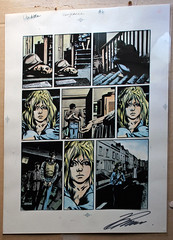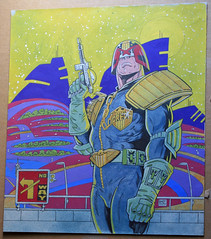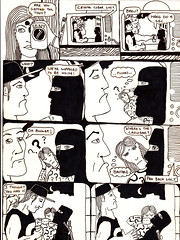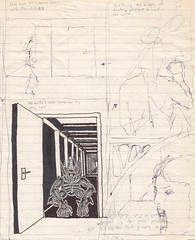Comics stuff
I've been a fan of comics for as long as I can remember. I started off as a kid with Buster, moved on to Battle and then 2000AD. Moving to London aged 17 I fell in with a bad crowd and got onto the hard stuff - Watchmen and V for Vendetta. I've never really been a fan of the Superhero comic, most of the comics I read ended up in the DC Vertigo line, so I suppose they would be classed as horror. For some reason I always preferred DC and didn't really get into any Marvel lines and I seemed to gravitate towards English writers, although that maybe because there was such an explosion of talent in the mid-80s and early 90s.
In the late 80's I started collecting original comic artwork, thanks mostly to the now defunct Comic Showcase store on Neal Street. I think my first purchase was a blue line from V for Vendetta.


In the mid 90's a wrote and drew my own tongue in cheek, derivative comic. 8 whole pages of Section 6, a superhero team of inept squatters. It was actually published in a small press anthology, but all 8 pages were shrunk to 1 side of A5 which didn't really do it justice (or maybe it did). I'm planning to put together an "Absolute" edition of the comic for my friends who were featured in it.


Anyway, to the point of this post. I follow quite a few comic artists on Twitter and in the last 2 days I saw a couple of links I felt I needed to share. David Peterson, author and artist of the fantastic Mouseguard comics (@mouseguard on Twitter) posted on his blog about his process. It's a fascinating and educational look at one artist's methods.
Neill Cameron, author and artist for Mo-Bot High (@neillcameron on Twitter) posted a link to a Disney "Comic Strip Artist's Kit". The Disney kit has been around for over 35 years but is just as relevant today.
As to my process, looking back at the sketches from about 15 years ago it appears to be: Make a doodle during a particularly boring meeting at work; base whole comic around single doodle. I did actually do thumbnails of each page, although they sometimes differed radically from the finished page. I definitely didn't plan how much text was going to go in each panel. In fact, in order to fit the text in and make it readable, after drawing the comics on A4 paper I photocopied them and blew them up to A3, re-inked them and then created text panels and speech bubbles on another sheet of paper, cut them out and glued them onto the A3 pages.


If you're interested in creating comics I recommend Understanding Comics by Scott McCloud and How to Draw Comics the Marvel Way by Stan Lee and John Buscema. There are lots of other good books out there too.
If you have children and you want to get them into comics and reading, check out The Phoenix Comic, a great new comic for kids with some of the top UK writers and artists working on it, which includes Neill Cameron's How to Make Awesome Comics.
For a taster of comic talent in the UK now you should read Nelson edited by Rob Davis and Woodrow Phoenix, a completely brilliant anthology. 54 British comic artists come together to write the story of Nel, from 1968 to the present day with each artist tackling 1 day in the life of Nel for each year of her life.
In other comics news, DC have announced a slew of Watchmen prequels. Hrrm.
In the late 80's I started collecting original comic artwork, thanks mostly to the now defunct Comic Showcase store on Neal Street. I think my first purchase was a blue line from V for Vendetta.


In the mid 90's a wrote and drew my own tongue in cheek, derivative comic. 8 whole pages of Section 6, a superhero team of inept squatters. It was actually published in a small press anthology, but all 8 pages were shrunk to 1 side of A5 which didn't really do it justice (or maybe it did). I'm planning to put together an "Absolute" edition of the comic for my friends who were featured in it.


Anyway, to the point of this post. I follow quite a few comic artists on Twitter and in the last 2 days I saw a couple of links I felt I needed to share. David Peterson, author and artist of the fantastic Mouseguard comics (@mouseguard on Twitter) posted on his blog about his process. It's a fascinating and educational look at one artist's methods.
Neill Cameron, author and artist for Mo-Bot High (@neillcameron on Twitter) posted a link to a Disney "Comic Strip Artist's Kit". The Disney kit has been around for over 35 years but is just as relevant today.
As to my process, looking back at the sketches from about 15 years ago it appears to be: Make a doodle during a particularly boring meeting at work; base whole comic around single doodle. I did actually do thumbnails of each page, although they sometimes differed radically from the finished page. I definitely didn't plan how much text was going to go in each panel. In fact, in order to fit the text in and make it readable, after drawing the comics on A4 paper I photocopied them and blew them up to A3, re-inked them and then created text panels and speech bubbles on another sheet of paper, cut them out and glued them onto the A3 pages.


If you're interested in creating comics I recommend Understanding Comics by Scott McCloud and How to Draw Comics the Marvel Way by Stan Lee and John Buscema. There are lots of other good books out there too.
If you have children and you want to get them into comics and reading, check out The Phoenix Comic, a great new comic for kids with some of the top UK writers and artists working on it, which includes Neill Cameron's How to Make Awesome Comics.
For a taster of comic talent in the UK now you should read Nelson edited by Rob Davis and Woodrow Phoenix, a completely brilliant anthology. 54 British comic artists come together to write the story of Nel, from 1968 to the present day with each artist tackling 1 day in the life of Nel for each year of her life.
In other comics news, DC have announced a slew of Watchmen prequels. Hrrm.
Labels: comics

